Every experienced digital marketer knows that while acquiring leads can be difficult, losing a lead isn’t hard at all. Too often, marketers lose a lead because of a silly mistake.
Let’s take a minute to look at the vast digital marketing landscape in terms of the complicated dating world. Capturing a prospect’s attention is like wooing somebody; winning a lead is akin to scoring a date with that person, and converting that lead into a customer is like developing a more serious relationship with them.
In both cases, building a strong relationship requires substantial time and effort right from the beginning, and working hard to nurture the relationship throughout every stage. This includes:
- Meeting your potential customers/dates where they are to initiate the relationship
- Maintaining a balance of showing interest, but not being too pushy or aggressive too fast
- Continuing to impress them at every stage of the marketing funnel/relationship
Make a mistake at any one of those three, and you could easily sabotage a promising relationship. To avoid this, you must review all parts of your conversion process. Let’s take a look at the possibilities.
How to lose a lead in 10 ways
1. Not focusing on a single offer
It’s your job to show visitors exactly what action is required to move forward on their customer journey. Too many options will lead to confusion and could scare visitors away. Only ask for one action on the entire page, and use a clear call-to-action to encourage it.
A post-click landing page is the most effective way to promote a single offer, since this is where the conversion happens. Other web pages tend to have too many distractions, including header and footer navigation menus, social media links, etc. For comparison, look at one of Moz’s web pages, followed by one of their post-click landing pages:
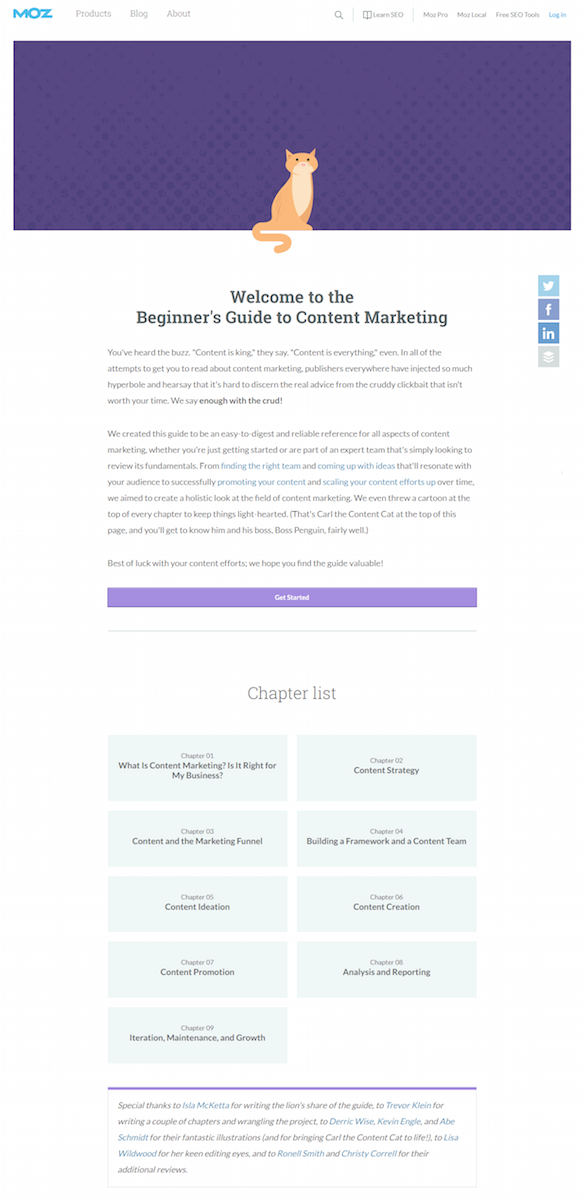
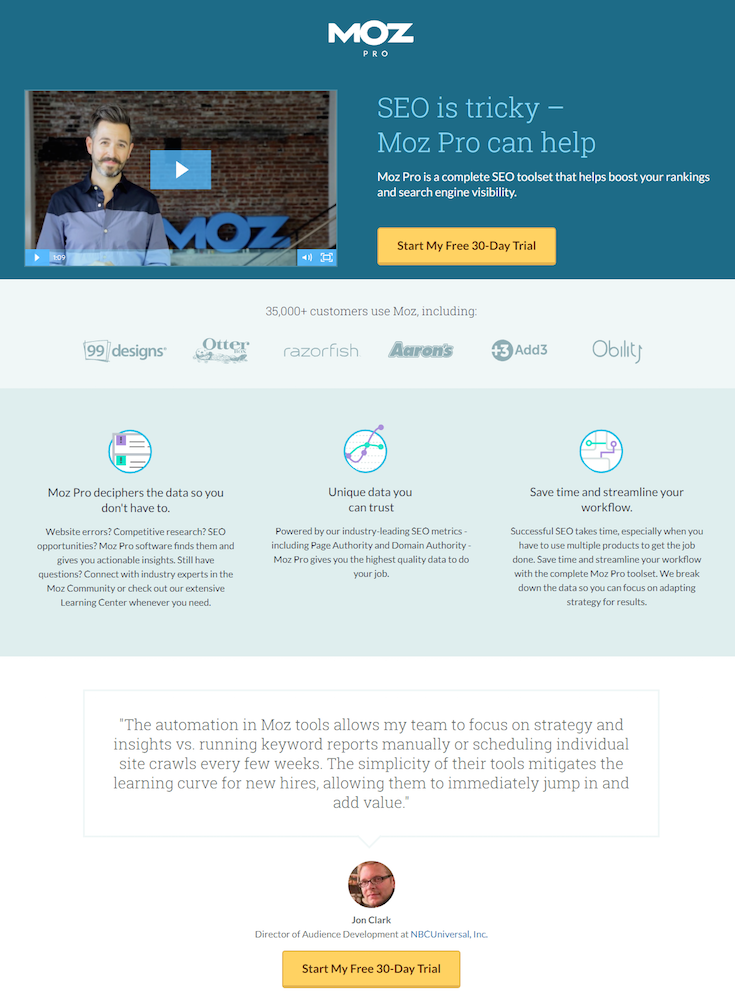
The first page is filled with distractions, exit links, and isn’t dedicated to a single offer. Meanwhile, the post-click landing page, only promotes their free 30-day trial with no navigation or social media links anywhere. However, the hyperlinked Moz logo and copy underneath the customer testimonial could also be removed to eliminate any temptation for visitors to click.
Bottom line is this: maintain a 1:1 conversion ratio so that people have no other choice but to convert or close the browser tab to exit.
2. Not fulfilling your promise in the ad
When people click online ads, they expect to get more information about the offer on the next page. When that doesn’t happen they back out immediately and you’ve lost them. For example, searching for “cloud marketing software” shows the ads below. Notice how Act-On’s headline has the exact search phrase, so it appears to be spot-on relevant to the query:
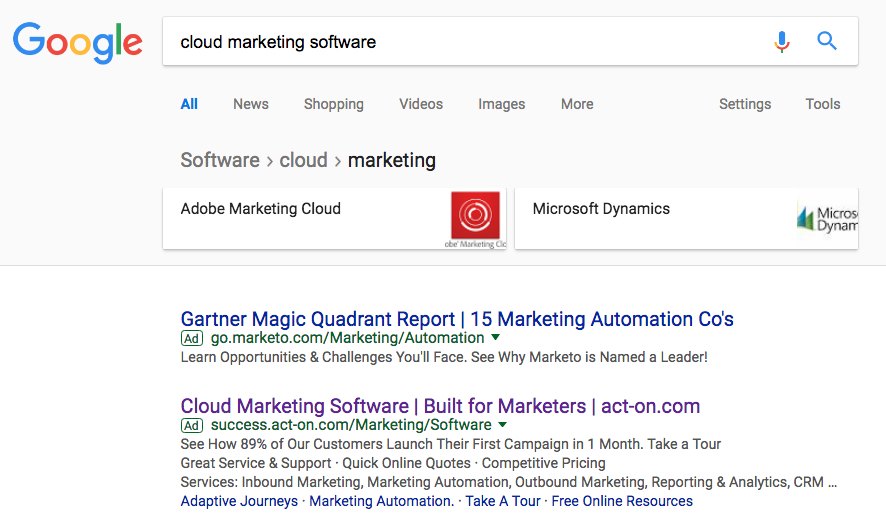
However, once the ad is clicked, prospects are brought to a post-click landing page with no mention of cloud marketing software. This provides a negative experience and probably causes visitors to bounce off the page immediately:
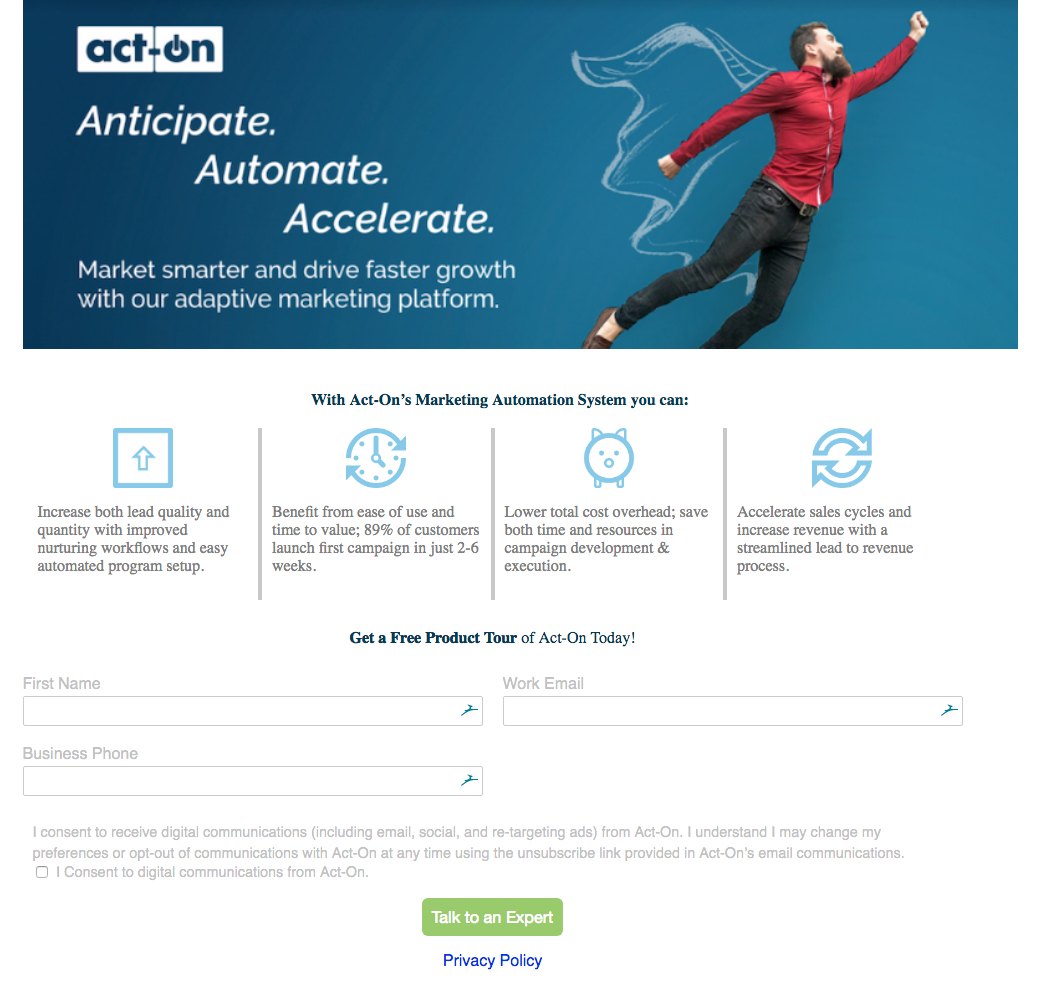
Message match can help you avoid this problem altogether by providing web users with a consistent experience. Consistency comes in several forms: the same headline on both the ad and post-click landing page, highlighting special ad copy, using the same imagery, colors, and more.
ConnectWise demonstrates optimal message match between their banner ad and corresponding post-click landing page. Headlines, imagery, and colors all match so prospects know they are in the right place to redeem the offer:
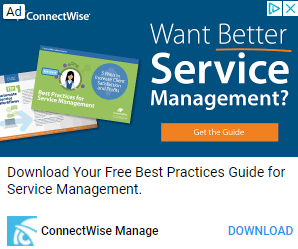
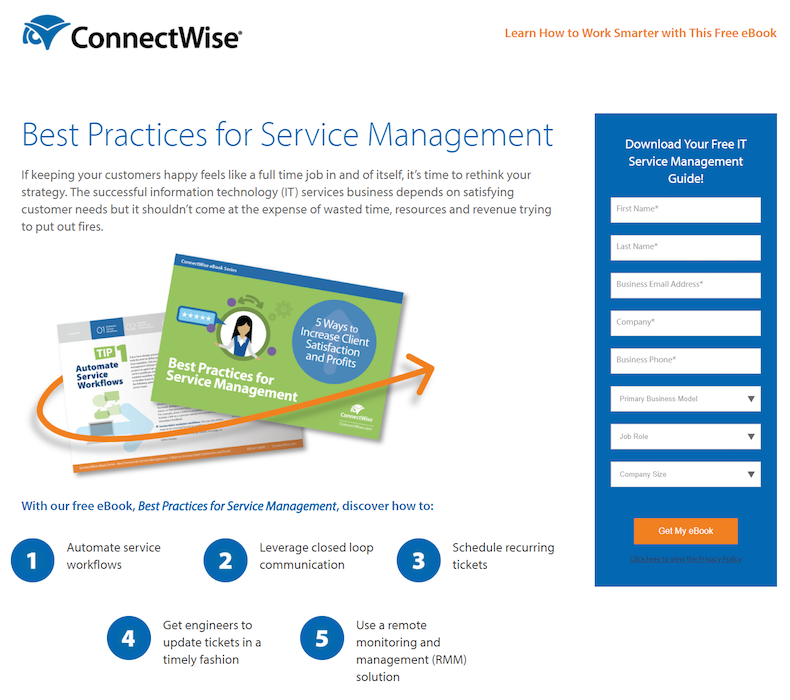
Web users click on ads because they are intrigued by the offer. When they don’t get what they expect after clicking through, they’re likely to find someone else who can meet their needs.
3. Slow page loads
One of the easiest ways to lose a lead is with a slow-loading page. Google’s own data reports that more than 50% of mobile web users will abandon a web page if it doesn’t load in 3 seconds or less. Unfortunately, the average page load speed is much longer for many industries:
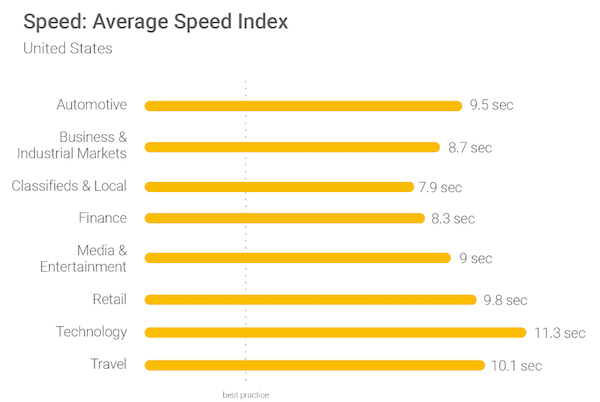
You can quickly test your web page speed with Google PageSpeed Insights. Should your results come back poorly, there are several actions you can take, including:
- Taking advantage of Google AMP
- Avoiding post-click landing page redirects
- Compressing images
- Using single, static images instead of carousels
- Prioritizing above-the-fold content
- Using browser caching
Addressing your page load speed on those factors could be the difference in prospects sticking around long enough to consider your offer. After all, if the page doesn’t load fast enough for them, they won’t convert.
4. Not securing your pages for Google Chrome
Back in February, Google Chrome announced their efforts to make the web a more secure place. Starting in July 2018, they will begin to label web pages as “not secure:”

For digital marketers, this should be a big wake-up call to comply with Chrome’s new standard or risk losing a lot of leads. Put yourself in your prospect’s shoes; if you arrived at a post-click landing page and noticed it was not secure, would you trust the company and submit your personal information?
To help ease any customer fears, Instapage announced in December 2016 that all customers on Core, Optimizer, Agency (Enterprise too) would have SSL certificates and be “secure.”
5. Not showing targeted offers to the right people
To get the most out of your ad campaign, you must first identify who your target audience is, and then segment your leads to best target them. This ensures you’re only showing targeted offers to the most relevant leads, and not wasting time on misplaced offers to them.
The chart below outlines the three primary stages of the buyer’s journey along with some example content for each stage. It is not a perfect science but a suggested guideline:
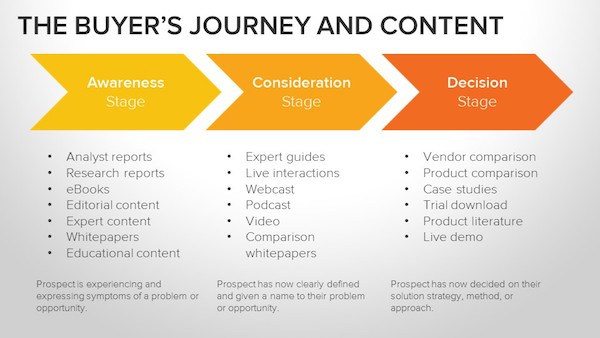
For example, if you present a software demo ad to someone at the very beginning of the buyer’s journey, it’s likely to be low converting because the prospect is not ready to purchase yet. However, showing the same ad to someone further along on the buyer’s journey has a much higher chance of conversion because they’ve gone through the awareness and consideration stages. Hence, they are more equipped to make a buying decision.
6. Not being active where your ideal customers hang out
You can’t realistically expect to generate leads if you’re not engaging with target prospects where they hang out online.
For example, if your target audience is women, Pinterest is a great place to spend your advertising efforts, since Pinterest users are 70% women and 30% men. If you’re highly focused on other social media platforms with completely different demographics, you’re missing out on all of those more appropriate prospects on Pinterest.
If your audience is seeking exploratory information or comparison shopping, for example, two great community sites to consider are Quora and Reddit. Here, you can search out questions relating to your business and provide thoughtful answers about your brand or industry. Be careful not to be too self-promotional though as those community users will be turned off from your content.
7. Slow and ineffective responses to questions on social media and review sites
One of the easiest ways to lose a lead is to make them feel like their time is not valued, because if they are not valued now, why would they think things would change if they become a customer?
From answering questions to responding to complaints, slow response times can be detrimental to acquiring leads and ultimately converting them into customers. And thanks to social media, the window of acceptable response time has become quite small.
According to a lead management study, the odds of qualifying a lead in 5 minutes versus 10 minutes decreases 4 times, and in 5 minutes versus 30 minutes decreases 21 times. So if you fail to engage with your leads promptly — or even worse, ignoring them all together — you’re pretty much guaranteed to lose them.
Here’s an example of a review about Pipedrive on Capterra:

The company was rated poorly, partly because they didn’t respond to this particular customer despite several attempts to make contact. Ironically, Pipedrive also didn’t respond to this review, so it’s probably safe to say this person has now been lost for good.
Here’s another example of a review about the same company:
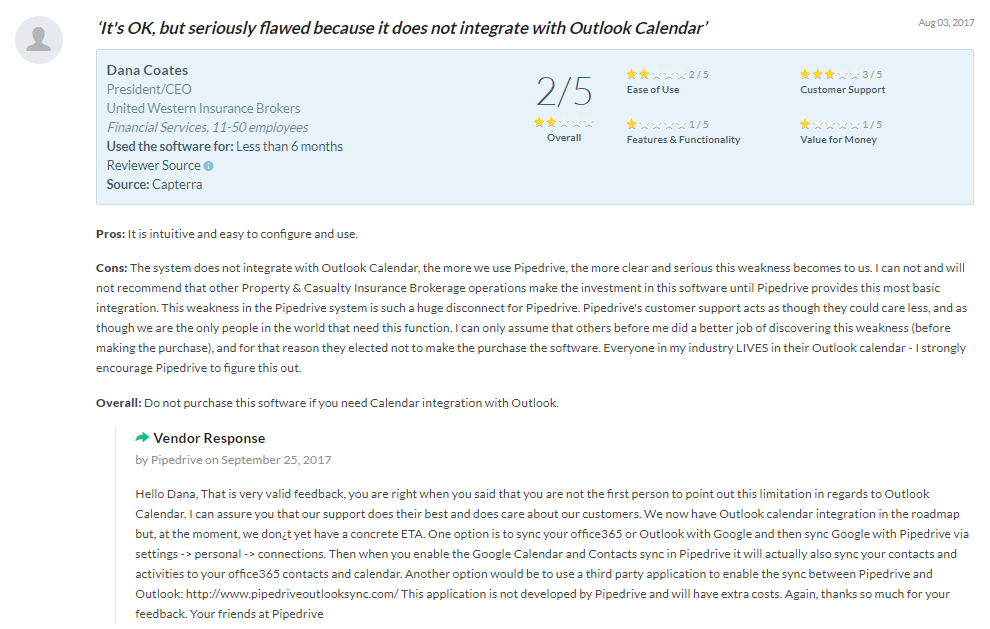
Pipedrive responded this time but unfortunately, it took them nearly two months to do so.
In addition to response time, how a company responds is also critical. Is the company defensive against negative feedback and constructive criticism, or do they welcome all types of feedback and consider it for future improvements?
In the example above, Pipedrive did an excellent job of responding welcomingly and appropriately. They made it clear that they appreciated the feedback and were in the process of remedying the problem. They also offered a solution in the meantime.
Whether your company is struggling to respond promptly or struggling with the type of response it provides, consider whether or not you have a supportive, educated, and sufficient customer service team to measure up to these standards. Your team should be readily available to engage with leads, answering any questions or concerns they may have, and successfully guiding them through your conversion funnel.
8. Missing social proof and other trust signals
If prospects can’t trust your brand or quality of service, how do you expect them to be brand advocates for you in the future? They require social proof to help convince them to purchase. These trust signals can come in a variety of ways in digital marketing such as testimonials, case studies, company logos, industry awards received, etc.
On this Instapage post-click landing page, we incorporate many Trustpilot reviews that highlight our ease of use and ability to create high-converting pages:
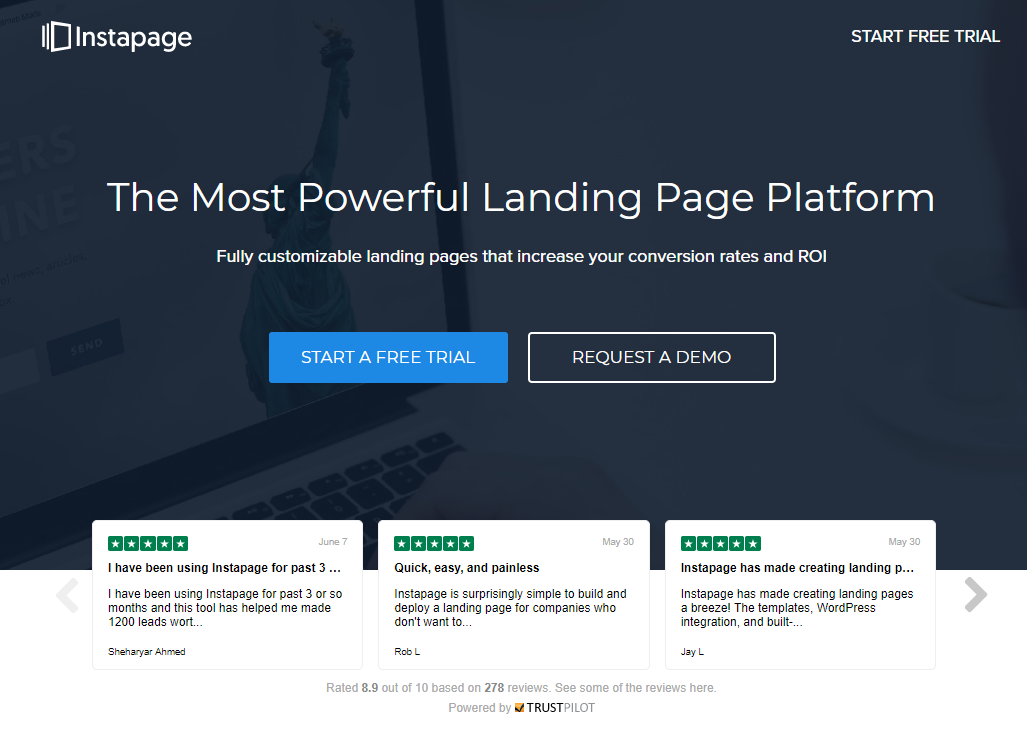
Further down the page, we show a detailed customer testimonial, complete with headshot, a direct quote, full name, company affiliation, and job title. By including such details, there is no confusion as to who Anne Fleshman is and what she enjoys about the Instapage platform:
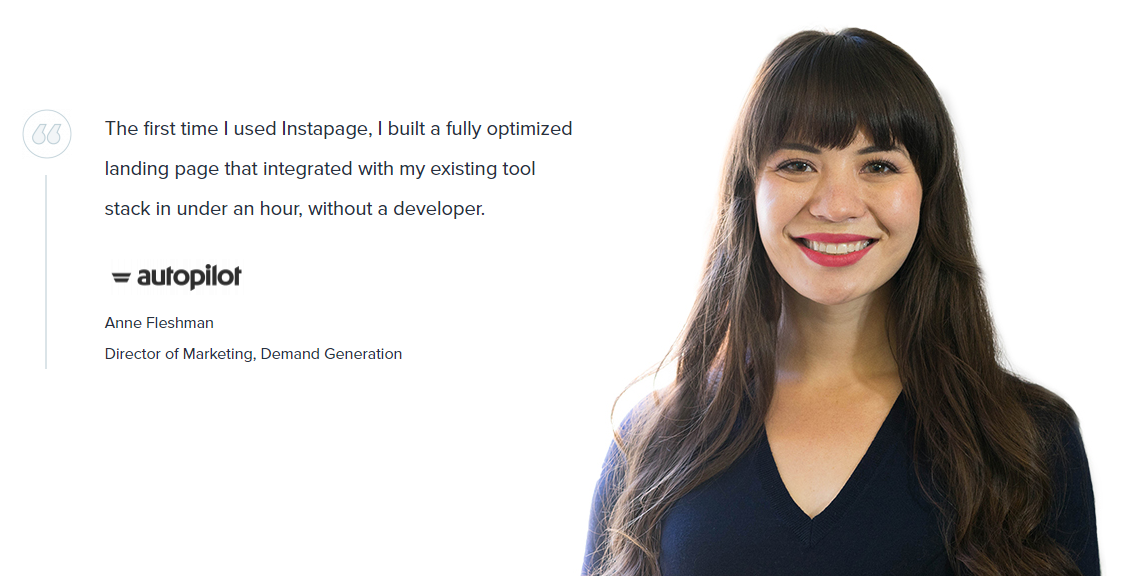
9. Asking for too much
Requesting too much personal information on lead capture forms can easily intimidate prospects and lower your conversion rate. Some experts say that fewer form fields produce higher conversion rates, but as the chart below shows, the type of offer/form also plays a role in how many fields should be included on your form:
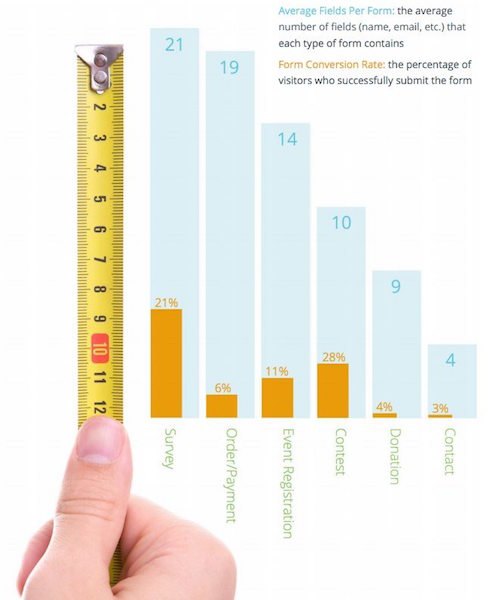
If your offer is one that requires a lot of information, multi-step forms — like this one on American Public University’s post-click landing page — can help you do it strategically. Notice how the form description directly states that this is a 2-step from and shows a progress indicator:
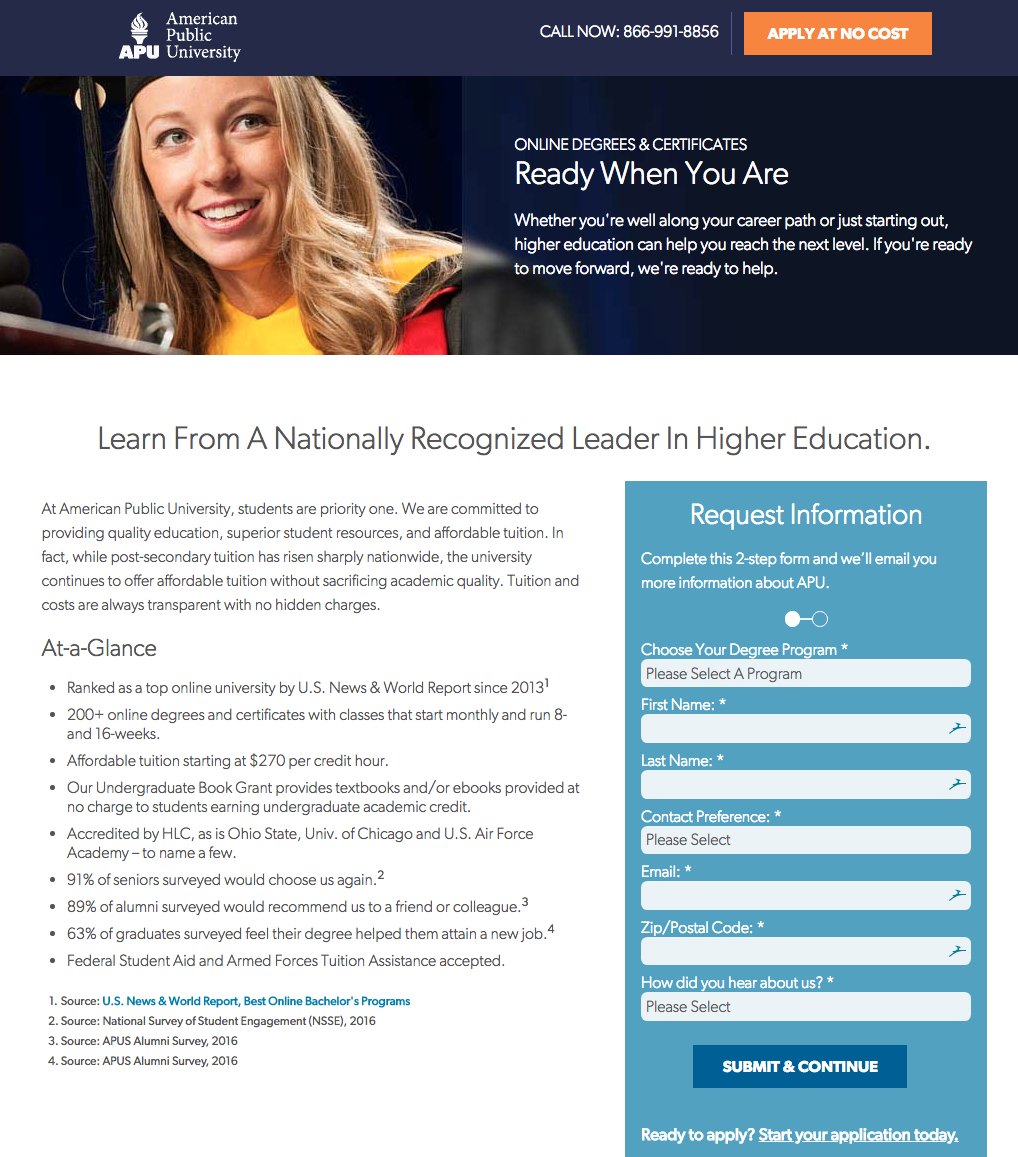
Multi-step forms are longer forms that are broken up into shorter, less daunting steps. They allow your leads to demonstrate their interest by completing a short form (only one form field in the example above) and then proceeding to additional form fields, step-by-step.
Since additional information is requested only after baseline information has already been submitted, multi-step forms can also reduce post-click landing page friction.
10. Being too aggressive with retargeting
There are essentially two ways of being “too aggressive” with retargeting ads:
- Showing too many ads too frequently
- Showing the same ad repeatedly with no rotation
When it comes to retargeting campaigns, there’s a fine line to balance. The whole intent of retargeting is to keep your brand in front of prospects without them actively seeking you out. Show up too often, though, and will annoy them quickly. Just because somebody visited your page one time for a few seconds, doesn’t mean they’re ready to convert, so bombarding them with retargeting ads as soon as they leave will likely make them feel that you’re too aggressive too quickly.
It’s also difficult to get ad clicks if you repeatedly show the same ad (or very similar-looking ads), without rotating any other ads into the mix. Due to inattentional blindness, users stop noticing your ad after seeing it so often, and they consider it to be a part of the page background. So if they don’t see it, they won’t click.
Stop losing leads, starting now
All too often, marketers lose a lead in a fraction of the time it took them to obtain it. This doesn’t have to be you. Don’t sabotage your promising relationships by making any of these silly mistakes. Use the examples above to identify where you might be losing leads and remedy the issue before it’s too late.
Always connect all your ads to personalized post-click landing pages to lower your cost per customer acquisition. Start creating your dedicated post-click pages by signing up up for an Instapage Enterprise demo today.

See the Instapage Enterprise Plan in Action.
Demo includes AdMap™, Personalization, AMP,
Global Blocks, heatmaps & more.
